Everything You Need to Know About Amazon VAT Services: Definition, Calculation, Registration, Exemption, and More
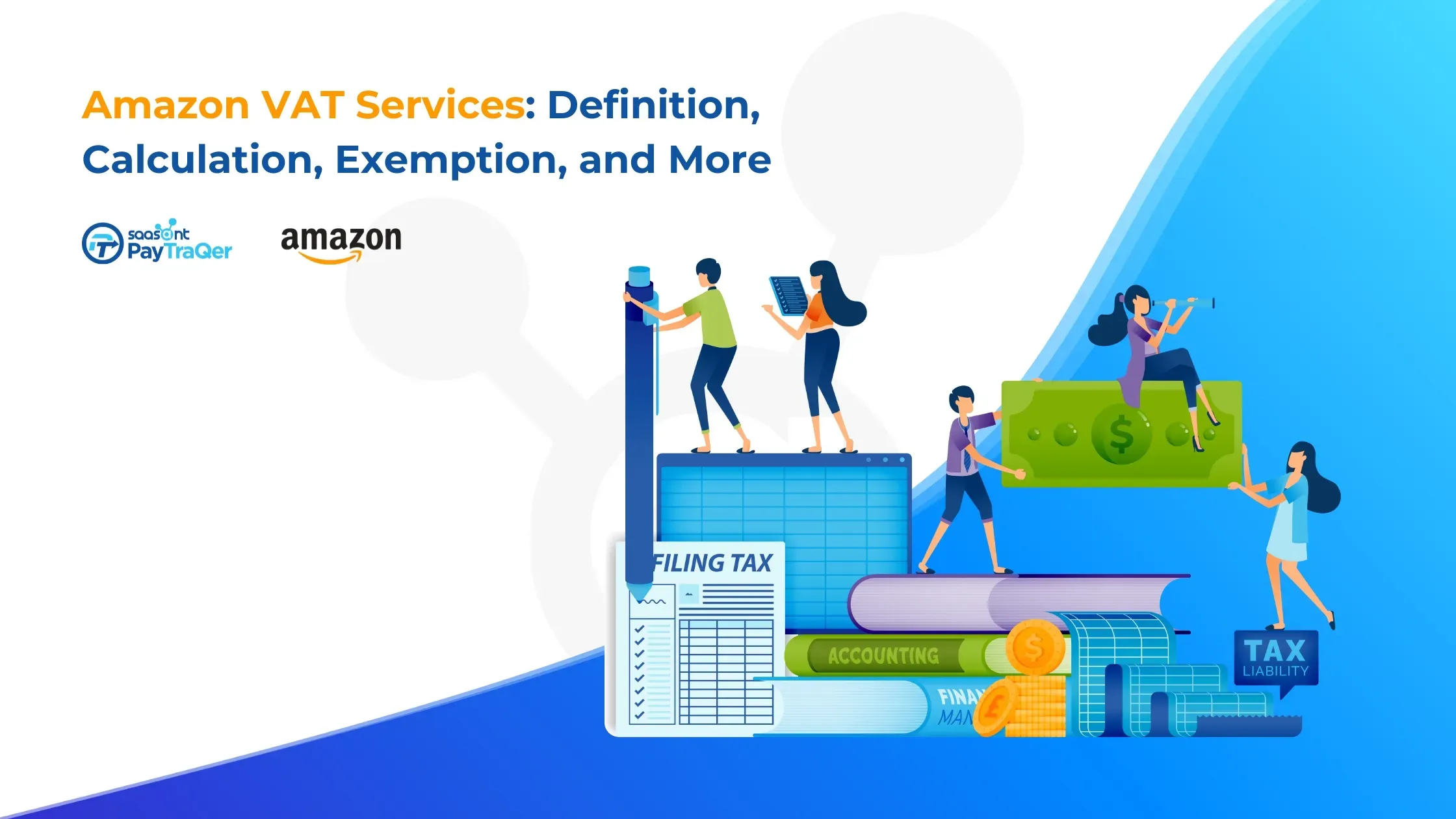
As businesses grow, so do their tax obligations. For companies operating in the European, Middle Eastern, and African (EMEA) regions, the Value Added Tax (VAT) is a crucial element of their tax compliance strategy.
Amazon is no exception, as they are required to collect VAT from their customers on behalf of the relevant tax authorities. The VAT rates and Goods & Service Tax (GST) rates that Amazon customers are charged vary depending on the country in which their account is located.
VAT is an important element in accurate bookkeeping practice, and its rates range from 16% in Luxembourg to 27% in Hungary. It's worth noting that some countries have different VAT rates depending on whether or not the customer has a tax registration number.
In this article, we will provide an overview of Amazon VAT services, including its definition, calculation, registration, exemption, and more. Let’s begin.
Contents
Value Added Tax Definition
How to Calculate VAT on Amazon Sales
Does Amazon Charge VAT on Seller Fees
Amazon VAT Registration
Amazon VAT Services, How Do You Collect Returns
Summing it Up
FAQs
Value Added Tax Definition
Value Added Tax (VAT) is a consumption tax that is applied to goods and services at each stage of the supply chain, from production to the final point of sale. It is a tax on the value added to a product or service at each stage of production and distribution.
The VAT system is designed to be a more efficient way of collecting taxes because it allows for the tax burden to be spread across all levels of production and consumption. In practice, VAT is charged on the value of goods and services sold by businesses, and the amount paid is then offset by the VAT paid on purchases made by the business.
This means that the VAT paid on purchases is subtracted from the VAT charged on sales, and the difference is then paid to the tax authority. The VAT charged on sales is often referred to as output VAT, while the VAT paid on purchases is known as input VAT.
VAT rates vary between countries, with some countries having multiple rates depending on the type of goods or services being sold. For example, in the United Kingdom, there are different rates for essentials such as food and housing, standard rate, and reduced rate for certain goods and services.
In the European Union (EU), the VAT rate is harmonized across member states, with a minimum rate of 15% and a maximum rate of 27%. The VAT system is widely used around the world, and it is an important source of revenue for many governments.
It is a complex tax system that requires careful record-keeping and compliance, which is why businesses often rely on professional services to ensure that they are meeting their VAT obligations.
How to Calculate VAT on Amazon Sales
Calculating VAT on Amazon sales can be a complex process that depends on various factors, including the country where the sale is taking place, the type of product or service being sold, and your VAT status. Here are the steps to calculate VAT on Amazon sales:
1. Determine the Applicable VAT Rate
The applicable VAT rate can vary between countries and may also differ based on the type of product or service being sold. For example, in the United Kingdom, the standard VAT rate is 20%, but there are reduced rates of 5% and 0% for certain products and services.
In the European Union (EU), VAT rates can vary from 17% to 27%, depending on the country. It is important to determine the correct VAT rate for the country where the sale is taking place to ensure that you are charging the correct amount of VAT.
Here is a table detailing the current acceptable rate by the EU:
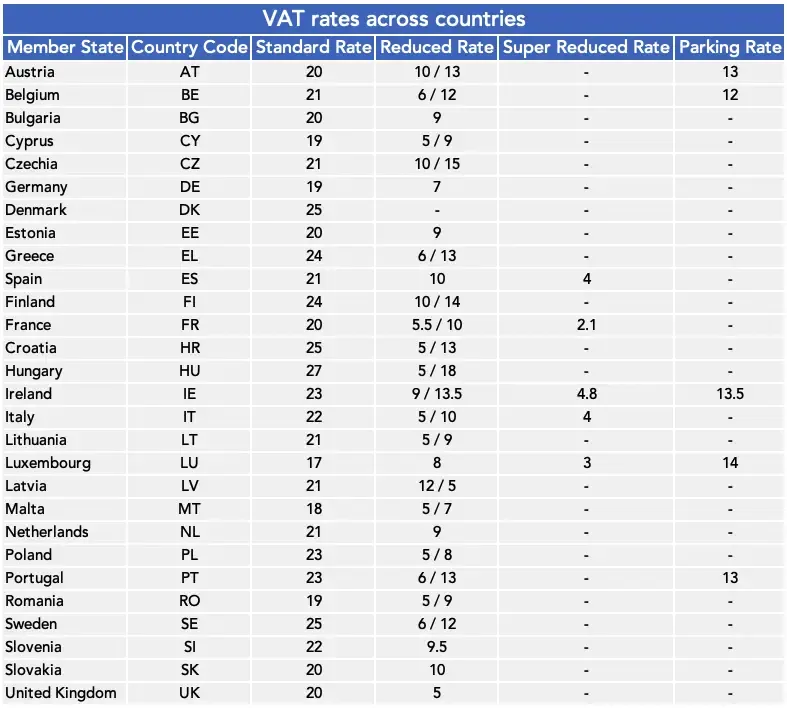
2. Determine Your VAT Status
It is important to check the local tax regulations to determine whether you are eligible to register for VAT and charge VAT on your Amazon sales. Your VAT status is determined by the tax regulation guiding you. As a registered VAT payer, you will be required to charge VAT on your sales. However, if you are not registered for VAT, you will not be required to charge VAT.
3. Calculate VAT
To calculate VAT on Amazon sales, you need to multiply the net sale price (i.e., the price of the product or service excluding VAT) by the applicable VAT rate. For example, if the net sale price is $100 and the VAT rate is 20%, the VAT amount would be $20.
Therefore, the total price charged to the customer would be $120. It is important to ensure that you are charging the correct amount of VAT to avoid penalties and compliance issues.
4. Record VAT
If you are a registered VAT payer, you will need to keep accurate records of the VAT you charge on your Amazon sales. This will help you to file your VAT returns and comply with local tax regulations.
You should keep copies of invoices and receipts, and record the VAT charged and paid for each transaction. By keeping accurate records, you can ensure that you are complying with local tax regulations and avoid penalties for non-compliance.
Calculating VAT on Amazon sales requires you to determine the applicable VAT rate, your VAT status, and to calculate the VAT amount for each sale. By keeping accurate records of your VAT transactions, you can ensure that you are compliant with local tax regulations and avoid penalties for non-compliance.
VAT Calculation Services Amazon
VAT calculation services for Amazon are third-party tools that can help sellers calculate VAT on their Amazon sales. These tools can automate the process of calculating VAT and can also help sellers to manage their VAT compliance.
There are various VAT calculation services available for Amazon sellers, each with their own features and pricing. Some popular VAT calculation services for Amazon include Taxamo and TaxJar.
Features of VAT Calculation Services for Amazon
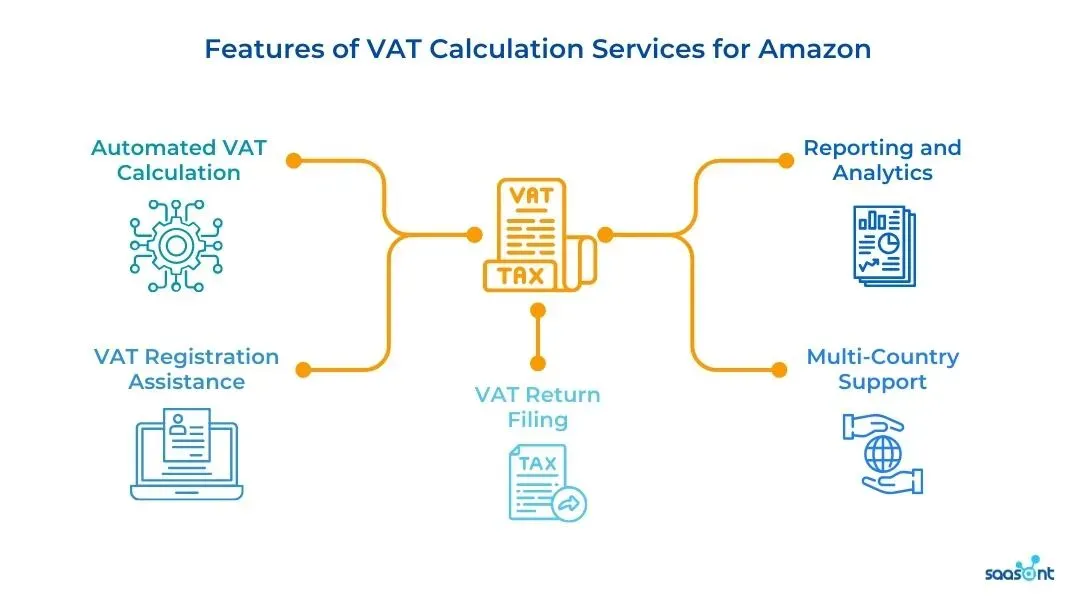
1. Automated VAT Calculation
VAT calculation services can automatically calculate the correct amount of VAT for each Amazon sale, based on the applicable VAT rate and the seller's VAT status. This can save time and reduce the risk of errors.
2. VAT Registration Assistance
Some VAT calculation services can assist sellers with VAT registration in the relevant countries. This can be helpful for sellers who are new to selling on Amazon and are unsure about their VAT obligations.
3. VAT Return Filing
They can also assist with VAT return filing. This can be helpful for sellers who are not familiar with the local tax regulations and want to ensure that they are complying with their VAT obligations.
4. Multi-Country Support
It supports multiple countries, which can be helpful for sellers who sell in multiple Amazon marketplaces. This can ensure that sellers are charging the correct amount of VAT for each sale, regardless of the country.
5. Reporting and Analytics
Finally, VAT calculation services provide reporting and analytics features that can help sellers to monitor their VAT compliance and make informed business decisions.
Pricing of VAT Calculation Services for Amazon
The pricing of VAT calculation services for Amazon can vary depending on the provider and the features offered. Some providers charge a flat fee per month, while others charge based on the number of transactions processed.
Amazon sellers should compare the features and pricing of different VAT calculation services to choose the one that best suits their needs and budget.
Does Amazon Charge VAT on Seller Fees
Yes, Amazon charges VAT on seller fees in accordance with local tax regulations. The specific VAT rate and the fees that are subject to VAT may vary depending on the country where the sale takes place.
Sellers should factor in the VAT charged on their Amazon seller fees when calculating their overall VAT liability. Sellers can also claim back the VAT paid on their seller fees as input tax, which can help to reduce their overall VAT liability.
Amazon VAT Registration
Amazon VAT registration is a requirement for Amazon sellers who are selling their products in countries where Value Added Tax (VAT) is applicable. The VAT registration process enables sellers to comply with the tax obligations in the countries where they are selling their products on Amazon.
The process of Amazon VAT registration can vary depending on the country where the seller is registering. However, there are some general steps that sellers can follow to register for VAT:
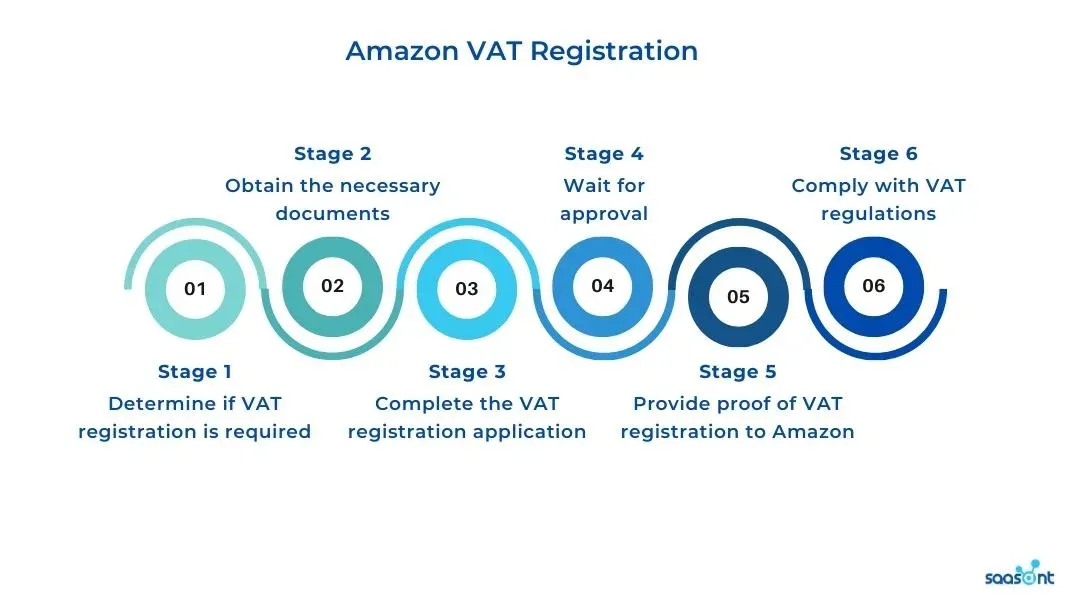
1. Determine if VAT registration is required
Before registering for VAT, it is important for Amazon sellers to determine whether they are required to do so in the country where they sell their products. This will depend on factors such as the seller's sales volume, the value of the products sold, and the country-specific VAT thresholds.
2. Obtain the necessary documents
Once a seller has determined that VAT registration is required, they will need to obtain the necessary documents to support their application. This typically includes proof of business registration and proof of address. The specific documents required will vary depending on the country.
3. Complete the VAT registration application
The next step in the Amazon VAT registration process is to complete the VAT registration application. This typically involves filling out an online form or submitting a paper application to the relevant tax authority.
The application will require sellers to provide detailed information about their business, including their VAT number, contact information, and details of their products or services.
4. Wait for approval
After the VAT registration application has been submitted, the seller will need to wait for approval from the tax authority. This can take several weeks or months, depending on the country and the volume of applications being processed.
Sellers should keep track of their application and follow up with the tax authority if they do not receive a response within a reasonable timeframe.
5. Provide proof of VAT registration to Amazon
Once the seller has received their VAT registration approval, they will need to provide proof of their VAT registration to Amazon. This can typically be done by submitting a copy of the VAT registration certificate or other relevant documentation to Amazon's Seller Central platform. Sellers should ensure that their VAT registration information is accurate and up-to-date to avoid any issues with Amazon or local tax authorities.
6. Comply with VAT regulations
After the seller has registered for VAT and provided proof of their VAT registration to Amazon, they will need to comply with local VAT regulations. This can include issuing VAT invoices, submitting VAT returns, and maintaining accurate records of sales and purchases.
Sellers should ensure that they understand the local VAT regulations and seek professional advice if they are unsure about their obligations. Compliance with VAT regulations is essential for avoiding penalties and maintaining a good reputation as an Amazon seller.
Amazon VAT Number
An Amazon VAT number is a unique identifier assigned to Amazon sellers who are registered for Value Added Tax (VAT) in the country where they sell their products.
The VAT number is used to identify the seller as a registered VAT business, and is required to be displayed on VAT invoices and other VAT-related documents. Amazon requires sellers to provide their VAT number to ensure compliance with local VAT regulations.
This is necessary for sellers who sell products in countries where VAT registration is mandatory or for those who wish to take advantage of Amazon's VAT calculation and collection services. Amazon also uses the VAT number to verify the accuracy of the VAT charged on sales and to remit VAT payments to the relevant tax authorities.
Tip: To obtain an Amazon VAT number, a seller must first register for VAT with the relevant tax authority in the country where they sell their products. Once the registration process is complete and the VAT number is assigned, the seller can then provide this information to Amazon through their Seller Central account.
Amazon Web Services VAT Number
AWS is a cloud-based platform that provides various computing services, storage, and other functionalities to businesses and individuals. AWS operates globally and is subject to VAT regulations in the countries where it operates.
For AWS (Amazon Web Services), VAT is charged on the services provided to customers in EU member countries. The VAT rate varies depending on the country, and AWS handles the VAT registration, collection, and payment on behalf of its customers.
When businesses use AWS services, they may be required to pay VAT on the services they receive. To comply with VAT regulations, AWS provides VAT invoices to customers, which include their VAT registration number.
The AWS VAT registration number is separate from the Amazon VAT registration number used by Amazon sellers. Businesses that use both Amazon and AWS services may have separate VAT registration numbers for each platform.
Businesses need to ensure that their AWS VAT registration number is accurate and up-to-date to avoid potential issues with local tax authorities. Businesses should also maintain records of their AWS VAT invoices to ensure proper documentation of VAT payments.
Do US Companies Have a VAT Number
No, US companies do not have a VAT number. The United States does not have a Value Added Tax (VAT) system in place like many other countries. Instead, the US uses a sales tax system that is imposed at the state and local levels.
As such, US businesses are not required to register for a VAT number in the US or in other countries that have a VAT system. However, if a US business sells goods or services to customers in a country that has a VAT system, the business may be required to register for VAT in that country and obtain a VAT number.
The rules for VAT registration vary by country and are generally based on factors such as the volume of sales in that country, the type of goods or services being sold, and the location of the business.
Therefore, US businesses that sell goods or services in countries with a VAT system should consult with a tax professional or legal expert to determine their obligations with respect to VAT registration and compliance.
How to Get a VAT Number In The US
As the United States does not have a Value Added Tax (VAT) system in place, there is no VAT number to obtain. Instead, the US uses a sales tax system that is imposed at the state and local levels.
If you are a US-based business, you may need to register for a sales tax permit with the state or local government where your business is located. The requirements for sales tax registration vary by state, but generally include the following steps:

1. Determine your sales tax nexus
Nexus refers to the connection between your business and the state where you are required to collect sales tax. Nexus is established by a variety of factors, including physical presence (e.g., having an office, warehouse, or employees in the state) or economic activity (e.g., reaching a certain level of sales in the state).
2. Register for a sales tax permit
Once you have determined your nexus, you will need to register for a sales tax permit with the state or local government where your business is located. You can usually register online or by mail, and will need to provide information about your business, including your tax identification number.
3. Collect and remit sales tax
Once you have obtained your sales tax permit, you will need to collect sales tax on taxable sales made in the state or local jurisdiction where your business has nexus. You will also be responsible for remitting the sales tax to the appropriate government agency on a regular basis (usually monthly or quarterly).
Kindly note that the rules for sales tax vary by state and locality, and can be complex. It is recommended that you consult with a tax professional or legal expert to ensure that you are complying with all applicable sales tax laws and regulations.
Amazon VAT Services, How Do You Collect Returns
When it comes to VAT services for Amazon sellers, collecting returns can be a complicated process. Here are the steps that you can take to collect returns:
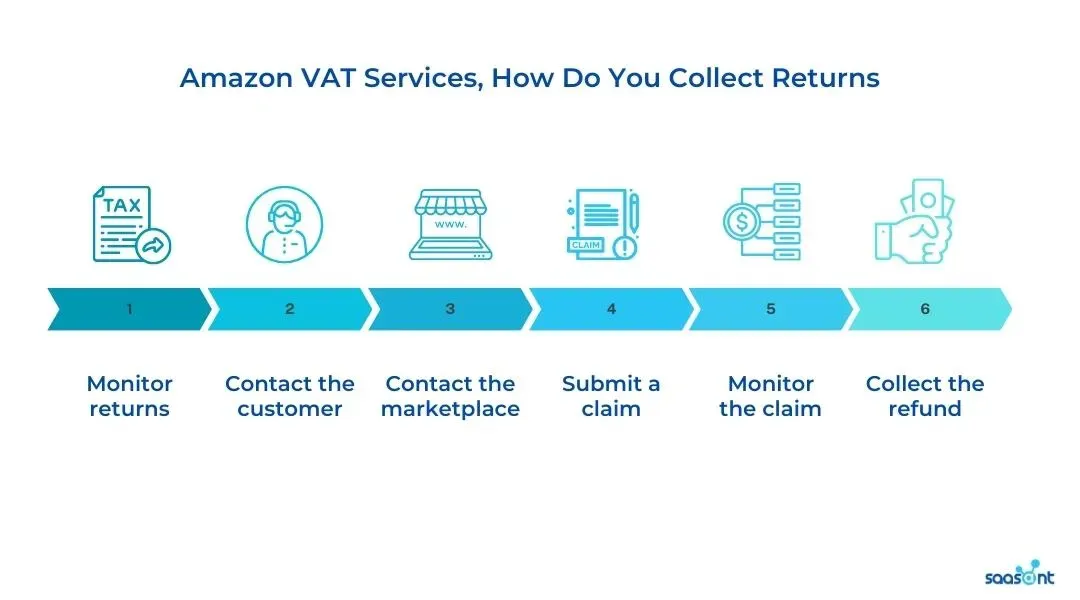
1. Monitor returns
The first step is to closely monitor your returns to ensure that they are being processed correctly. This involves checking to see that the correct amount of VAT has been refunded and that any goods returned from outside of the EU have been properly documented.
2. Contact the customer
If there is an issue with a return, you can contact the customer to try to resolve the issue. This might involve asking for additional documentation or clarification about the reason for the return.
3. Contact the marketplace
If the issue cannot be resolved with the customer, you may contact the marketplace where the sale took place. You need to work with the marketplace to determine the best course of action for resolving the issue.
4. Submit a claim
If the customer or marketplace does not resolve the issue, you may need to submit a claim to the tax authorities. This can be a time-consuming process, as it typically involves providing documentation and evidence to support the claim.
5. Monitor the claim
Once a claim has been submitted, continue to monitor the status of the claim to ensure that it is being processed correctly. This may involve following up with the tax authorities to check on the status of the claim.
6. Collect the refund
If the claim is approved, you will work with the tax authorities to collect the refund. This can take some time, as it typically involves navigating complex bureaucratic processes.
Amazon VAT Exemption
Amazon VAT exemption refers to the situation where a seller on the Amazon marketplace is not required to charge or pay VAT on their sales. This may occur if the seller's sales fall below a certain threshold or if they are engaged in activities that are exempt from VAT.
In some cases, sellers may also be eligible for a reduced VAT rate. It's important for sellers to understand the rules and regulations around VAT exemption, as failing to comply with these requirements can result in penalties and fines from tax authorities.
If you are an Amazon seller and believe you may be eligible for VAT exemption, it's recommended to consult with a tax professional or VAT service provider to ensure that you are compliant with all applicable regulations.
Which Services Are Exempt from VAT
The specific services that are exempt from VAT can vary depending on the country and jurisdiction in question. In general, exempt services are those that are considered essential or important for the well-being of individuals or the economy. Some common examples of exempt services may include:
1. Healthcare services
Medical treatment, including consultations, surgeries, and medication, is often exempt from VAT as it is considered an essential service.
2. Education services
Services provided by schools, colleges, and universities, including tuition fees and educational materials, may be exempt from VAT in some countries.
3. Financial services
Many financial services, including insurance, banking, and investment management, are often exempt from VAT.
4. Charitable services
Services provided by registered charities or non-profit organizations, such as donations or volunteer work, may be exempt from VAT.
5. Cultural services
Some cultural services, such as museums, libraries, and public art events, may be exempt from VAT.
6. Public transportation
Public transportation services, including buses, trains, and subways, may be exempt from VAT in some countries.
What Services Are Subject to VAT
The specific services that are subject to VAT can vary depending on the country and jurisdiction in question. However, in general, VAT is typically charged on the supply of goods and services that are used or consumed in the country where the tax is being levied.
Some common examples of services that are subject to VAT include:
1. Retail sales
When goods are sold directly to consumers to make money online, VAT is usually charged at the point of sale.
2. Telecommunications
Services related to phone, internet, and other communication technologies are often subject to VAT.
3. Accommodation and food services
When people stay in hotels or eat in restaurants, VAT is typically charged on the total cost of the service.
4. Professional services
Many professional services, including legal, accounting, and consulting services, are subject to VAT.
5. Construction and renovation services
Services related to building or renovating property are often subject to VAT.
6. Transportation services
When goods are transported within a country, VAT is often charged on the total cost of the service.
Amazon VAT Services Review
As an online marketplace, Amazon offers various VAT services to help sellers comply with VAT regulations and manage their VAT obligations. These services can be useful for sellers who are unfamiliar with VAT requirements or who want to simplify the process of collecting and remitting VAT.
Some of the Amazon VAT services include:
1. VAT Calculation Services
Amazon provides VAT calculation services to help sellers calculate and collect VAT on their sales. This service automatically calculates the correct VAT rate based on the product category, shipping destination, and other factors.
2. VAT Invoicing
Amazon also offers VAT invoicing services to sellers who sell to business customers in the EU. This service generates VAT-compliant invoices that include all the necessary information required by EU VAT regulations.
3. VAT Transactions Report
The VAT Transactions Report provides sellers with a detailed summary of all their VAT-related transactions. This report can help sellers monitor their VAT liabilities and identify potential issues or discrepancies.
4. VAT Registration and Filing Services
Amazon offers VAT registration and filing services for sellers who are required to register for VAT in multiple EU countries. This service can help simplify the process of registering for VAT and filing VAT returns.
5. Amazon VAT Services Europe
Amazon also offers a VAT Calculation Service for Pan-European Fulfillment by Amazon (FBA) sellers. This service helps sellers calculate and collect VAT on their FBA transactions in multiple EU countries.
How Do VAT Services on Amazon Work?
VAT (Value Added Tax) services on Amazon are designed to help businesses comply with VAT regulations when selling their products or services on Amazon's online marketplace. Essentially, Amazon provides a range of tools and services to help sellers manage their VAT obligations, including registration, calculation, invoicing, and reporting.
When selling products or services on Amazon, sellers may be required to register for VAT in the countries where they have a tax liability. Amazon provides guidance and support to help sellers determine their VAT registration obligations and register for VAT in the relevant countries.
Once registered, sellers can use Amazon's VAT calculation tool to determine the VAT due on each sale. The tool takes into account the relevant VAT rates and calculates the VAT owed based on the seller's location and the location of the buyer.
This helps to ensure that sellers are charging the correct amount of VAT and avoiding any penalties for underpayment or non-compliance. Amazon also provides a VAT invoicing service that generates invoices on behalf of sellers for each sale, including the VAT charged.
This helps to streamline the invoicing process and ensure that sellers are meeting their VAT invoicing obligations.
Finally, Amazon provides a range of VAT reporting tools to help sellers prepare and submit their VAT returns to the relevant tax authorities. These tools provide an easy way to track VAT payments and refunds and ensure that sellers are meeting their reporting obligations.
Amazon VAT Services Fees
Amazon VAT services come at a cost, and sellers should be aware of the fees associated with these services before using them. The pricing for Amazon VAT services varies depending on the specific service and the seller's location.
For example, Amazon's VAT Calculation Service pricing is based on a percentage of the item price, with a minimum fee per transaction. The fee varies by country and product category, and sellers can find the pricing information for their specific location on the Amazon website.
The fees for VAT Invoicing and VAT Transactions Report services are included in the overall selling fees that sellers pay to Amazon, and there is no additional charge for these services.
Amazon's VAT registration and filing services are also available for a fee, which varies depending on the specific country and the number of registrations required. Sellers can choose to pay the fees per registration or purchase a package that includes multiple registrations.
VAT services payment is typically deducted from the seller's account balance or charged to the seller's credit card on file. The payment process is typically automated, and sellers can view their VAT services fees in their account dashboard.
You should factor in the cost of Amazon's VAT services when pricing your products and managing your finances. However, using these services can help simplify the process of collecting and remitting VAT and can help ensure compliance with VAT regulations.
Summing it Up
VAT compliance can be a daunting task for any business, especially when you're selling on a global marketplace like Amazon. But fear not, Amazon's VAT services are here to make your life a whole lot easier.
With Amazon's tools and support, you can easily register for VAT, calculate your taxes, generate invoices, and stay on top of your reporting obligations. Plus, you can rest easy knowing that you're complying with all the regulations and avoiding any pesky penalties.
So, whether you're a small business just starting out or a seasoned seller looking to streamline your VAT process, Amazon's VAT services are the way to go. Say goodbye to endless spreadsheets and confusing tax codes, and hello to more time and energy to focus on growing your business.
Don't let VAT compliance hold you back - embrace Amazon's services and take your business to the next level!
FAQs
What is VAT in Amazon?
VAT (Value Added Tax) is a type of consumption tax that is applicable in many countries around the world, including in Europe and the UK, where Amazon operates. A VAT in Amazon refers to the VAT charged on Amazon transactions, such as sales made by sellers on the platform.
Is There VAT on Amazon?
Yes, Value Added Tax (VAT) is applicable on certain Amazon transactions depending on various factors such as the product type, the location of the seller and the buyer, and the applicable VAT rates in those jurisdictions. Amazon provides VAT services and resources to help sellers manage their VAT obligations on the platform.
Does Amazon pay VAT for Services?
Yes, Amazon is required to pay VAT for the services it receives in accordance with the VAT regulations of the countries in which it operates. However, the specific details of how VAT applies to Amazon's services can vary depending on the nature of the service and the country in question.
What is Amazon VAT Calculation Service?
Amazon's VAT Calculation Service is a tool that helps sellers calculate the correct amount of Value Added Tax (VAT) on their Amazon sales. It automates the calculation process based on the seller's product information and the applicable VAT rates, making it easier for sellers to comply with VAT regulations and collect the correct amount of tax.
Does Amazon refund VAT?
Amazon does not refund VAT directly to buyers. However, buyers may be able to claim a refund of the VAT paid on their Amazon purchases if they meet certain criteria. The specific rules for claiming a VAT refund depend on the country in which the purchase was made and the buyer's residency status.
In general, non-EU residents may be eligible for a VAT refund on goods purchased in the EU if they export the goods outside of the EU within a certain time frame and meet other conditions. It is recommended that buyers check the relevant VAT refund rules and procedures for their country and situation.
Where is Amazon VAT invoice?
Amazon provides VAT invoices to customers for eligible purchases made on the platform. If you are a customer and need a VAT invoice for your purchase, you can find it in your order history. Here are the steps to follow:
Go to the "Your Orders" page on the Amazon website or app.
Locate the order for which you need a VAT invoice.
Click or tap the "Invoice" button next to the order Details.
If the order is eligible for a VAT invoice, you will see a "Download VAT Invoice" link.
Click or tap on the link to download the VAT invoice.
If you cannot find a VAT invoice for your order or have any questions about VAT invoices, you can contact Amazon customer support for assistance.
What is the current VAT rate?
The current VAT rate varies by country and region. In the European Union, for example, the standard VAT rate ranges from 17% to 27%, depending on the country. Some countries also have reduced VAT rates for certain products and services, such as food and children's clothing.
It is important to check the specific VAT rates for your country or region, as they can change over time and vary by product or service.